 Unlike its predecessor where William Adams was the only hero, Nioh 2 this time asks you to create your own character. Nothing really revolutionary, since we find the usual options – gender, haircut, morphology, eye color, face shape, voice tone, tattoos, scars, etc. Even if it seems obvious, it should be noted that the alterations made are essentially cosmetic. Once the administrative formalities have been completed, the developers take the time to explain the basic rules so as not to start the adventure naked. Two or three pieces of advice that weigh nothing against the plethora of subtleties that abound in the game, but that's precisely where all the intelligence of Team Ninja lies. Instead of drowning in a flood of mechanics – as Code Vein can clumsily do – we are left to learn in pain and seek solutions ourselves in the face of seemingly insurmountable obstacles. The best school. And to ensure that we are sufficiently armed psychologically to go to the end, the third boss once again acts as an entry ticket. In Nioh, it was Hino-Enma; in Nioh 2, Yatsu-no-Kami is in charge of making us pass the crash test. On YouTube, some have fun knocking it down in just four minutes. On our first run, it took us four hours, in the middle of the night. A struggle that marked us with a hot iron and which also allowed us to integrate without knowing it a whole bunch of precious reflexes afterwards. Result, the following three bosses were swept away in about ten attempts each, big max.
Unlike its predecessor where William Adams was the only hero, Nioh 2 this time asks you to create your own character. Nothing really revolutionary, since we find the usual options – gender, haircut, morphology, eye color, face shape, voice tone, tattoos, scars, etc. Even if it seems obvious, it should be noted that the alterations made are essentially cosmetic. Once the administrative formalities have been completed, the developers take the time to explain the basic rules so as not to start the adventure naked. Two or three pieces of advice that weigh nothing against the plethora of subtleties that abound in the game, but that's precisely where all the intelligence of Team Ninja lies. Instead of drowning in a flood of mechanics – as Code Vein can clumsily do – we are left to learn in pain and seek solutions ourselves in the face of seemingly insurmountable obstacles. The best school. And to ensure that we are sufficiently armed psychologically to go to the end, the third boss once again acts as an entry ticket. In Nioh, it was Hino-Enma; in Nioh 2, Yatsu-no-Kami is in charge of making us pass the crash test. On YouTube, some have fun knocking it down in just four minutes. On our first run, it took us four hours, in the middle of the night. A struggle that marked us with a hot iron and which also allowed us to integrate without knowing it a whole bunch of precious reflexes afterwards. Result, the following three bosses were swept away in about ten attempts each, big max.
Sure of its strength, Nioh 2 continues to impose its style with relentless rigor, to the point of taking up certain weaknesses.
 As of this writing, we haven't finished Nioh 2 yet (no need to lie to you), but only for time reasons. That fear of blocking – a stomach-crushing feeling when you have to try out a Souls-like – has been pushed back. Those who flipped the first Nioh will have no trouble getting back to their good old habits, like juggling between high, medium and low postures depending on the opponent. The opportunity to remember that the game still benefits from this incredible work on the animations: just by looking at the way the enemies (and our character as a result) hold their weapon, we are able to guess their stance. By dint of taking expensive, it even becomes instinctive. Nioh 2 then takes on the appearance of a ballet where the blades collide, where the impulse and the purification cancel the miasma of the Yôkai to better deliver the final blow to an exhausted enemy. When you have in your hands an ax or a hammer that Thor would not deny, it is of an unspeakable brutality, visceral too. Dynamic as possible, the game does not compromise with the laws of physics; understand by this that it is necessary to take into account the weight of its armor, under penalty of losing liveliness. Afterwards, it's also a question of style of play: you can very well get along with a semi-trailer if you know the patterns by heart. On the other hand, others will prefer to sacrifice a little defense to maintain some mobility. Still others will carefully scrutinize each bonus/penalty associated with a particular element; it can be significantly more effective than raw defensive stats. For example, if a boss fight takes place in a poisonous setting, it would probably be better to go for armor with high poison resistance.
As of this writing, we haven't finished Nioh 2 yet (no need to lie to you), but only for time reasons. That fear of blocking – a stomach-crushing feeling when you have to try out a Souls-like – has been pushed back. Those who flipped the first Nioh will have no trouble getting back to their good old habits, like juggling between high, medium and low postures depending on the opponent. The opportunity to remember that the game still benefits from this incredible work on the animations: just by looking at the way the enemies (and our character as a result) hold their weapon, we are able to guess their stance. By dint of taking expensive, it even becomes instinctive. Nioh 2 then takes on the appearance of a ballet where the blades collide, where the impulse and the purification cancel the miasma of the Yôkai to better deliver the final blow to an exhausted enemy. When you have in your hands an ax or a hammer that Thor would not deny, it is of an unspeakable brutality, visceral too. Dynamic as possible, the game does not compromise with the laws of physics; understand by this that it is necessary to take into account the weight of its armor, under penalty of losing liveliness. Afterwards, it's also a question of style of play: you can very well get along with a semi-trailer if you know the patterns by heart. On the other hand, others will prefer to sacrifice a little defense to maintain some mobility. Still others will carefully scrutinize each bonus/penalty associated with a particular element; it can be significantly more effective than raw defensive stats. For example, if a boss fight takes place in a poisonous setting, it would probably be better to go for armor with high poison resistance.
BEWARE OF LOOT
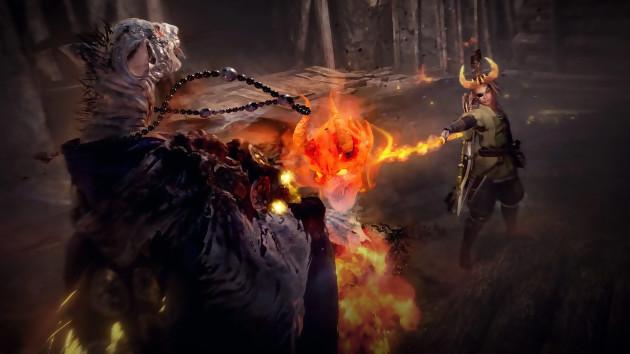 In summary, there are a thousand and one ways to kill and be killed. When the monsters arrive in large numbers, managing the space well is vital so as not to be taken as a traitor. Beware, however, of the camera, which is capricious at times, especially in tight places. When you end up mastering the scene and better managing the distance, you allow yourself dodges without pressing Cross, which keeps the Ki gauge intact for a next heavy attack. Be careful also not to gain confidence by placing the blow too many, the one that will expose us to a deadly counter. We have already lost 40 Amrita because we underestimated a basic mob. However, Nioh 000 reminds us every minute that hit in the void + depleted Ki gauge = more than a third of the life bar that jumps; and it can be almost all if you get caught by a creature in full rage. The requirement that has always characterized Team Ninja since the heyday of Ninja Gaiden has not evaporated, and the fact of now benefiting from Yôkai attacks explains why, from time to time, a second chance is not granted to the least misguidance. As we told you last month, there is a way to recover soul cores from certain corpses. After purifying them at the shrine, assigning them to a guardian spirit gives access to special skills, knowing that there are three types of guardian spirits: Bestial, Ferocious and Ghost. The explosive counter is the first advantage we get from the hybrid nature of our character. By simultaneously pressing R2 + Circle, we have the possibility of parrying the big attack of the Yôkai which, generally, is preceded by a red glow. A great way to inflict heavy Ki damage, in exchange of course for a portion of Anima. Note that the timing from one counter to another varies: in Bestial, you will have to hit the enemy before he lands his blow, while in Fierce and in Ghost, you will have to wait for him to launch his attack.
In summary, there are a thousand and one ways to kill and be killed. When the monsters arrive in large numbers, managing the space well is vital so as not to be taken as a traitor. Beware, however, of the camera, which is capricious at times, especially in tight places. When you end up mastering the scene and better managing the distance, you allow yourself dodges without pressing Cross, which keeps the Ki gauge intact for a next heavy attack. Be careful also not to gain confidence by placing the blow too many, the one that will expose us to a deadly counter. We have already lost 40 Amrita because we underestimated a basic mob. However, Nioh 000 reminds us every minute that hit in the void + depleted Ki gauge = more than a third of the life bar that jumps; and it can be almost all if you get caught by a creature in full rage. The requirement that has always characterized Team Ninja since the heyday of Ninja Gaiden has not evaporated, and the fact of now benefiting from Yôkai attacks explains why, from time to time, a second chance is not granted to the least misguidance. As we told you last month, there is a way to recover soul cores from certain corpses. After purifying them at the shrine, assigning them to a guardian spirit gives access to special skills, knowing that there are three types of guardian spirits: Bestial, Ferocious and Ghost. The explosive counter is the first advantage we get from the hybrid nature of our character. By simultaneously pressing R2 + Circle, we have the possibility of parrying the big attack of the Yôkai which, generally, is preceded by a red glow. A great way to inflict heavy Ki damage, in exchange of course for a portion of Anima. Note that the timing from one counter to another varies: in Bestial, you will have to hit the enemy before he lands his blow, while in Fierce and in Ghost, you will have to wait for him to launch his attack.
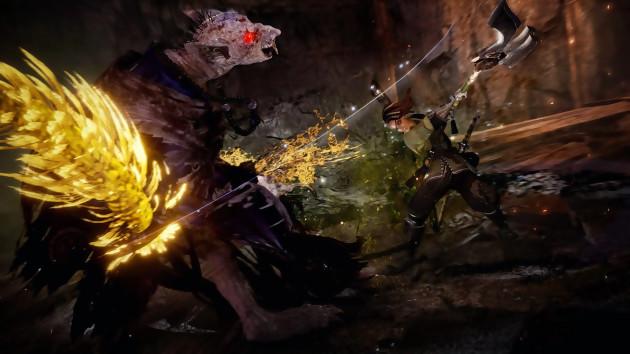 In addition to the counter explosive, we also take advantage of the Yôkai capacities which bring a good dose of depth to the combat system. It's simple, there are as many abilities as there are creatures. Thanks to the core of the Villager, a miner will strike the opponent with a pickaxe, while the soul of the Oni cyclops will trigger a tornado of straight lines. With the Waira Worm, our character will be able to sneak underground to better engulf the enemy, while Mitsume Yazura will come in handy for unleashing a burning breath on unwary monsters. Far be it from us to list all the abilities here, but you will have understood their usefulness. Naturally, all this is not free, and we must therefore constantly watch Amina's gauge to know if we have enough juice to invoke an ability. Note also that the protective spirits are subject to a limit of agreement, each soul core having a certain value. Basically, if the ceiling is set at 15 points, it will be impossible to go beyond. A sort of safeguard to prevent abuse. When the Amrita gauge is full, transforming into a Yôkai (Triangle + Circle) immediately increases our hero's power tenfold with, as a result, still other attacks, always depending on the type of the protective spirit. Personally, the Ferocious mutation is the most practical to start with its fast attacks and effective dodges. Bestial and Ghost metamorphoses require more skill, especially in terms of timing; once you've picked up the trick, it's regalade on regalade. Finally, let's not forget the soul fusion with which you can obtain cores with reinforced effects. Another option that makes us think twice before getting rid of an object.
In addition to the counter explosive, we also take advantage of the Yôkai capacities which bring a good dose of depth to the combat system. It's simple, there are as many abilities as there are creatures. Thanks to the core of the Villager, a miner will strike the opponent with a pickaxe, while the soul of the Oni cyclops will trigger a tornado of straight lines. With the Waira Worm, our character will be able to sneak underground to better engulf the enemy, while Mitsume Yazura will come in handy for unleashing a burning breath on unwary monsters. Far be it from us to list all the abilities here, but you will have understood their usefulness. Naturally, all this is not free, and we must therefore constantly watch Amina's gauge to know if we have enough juice to invoke an ability. Note also that the protective spirits are subject to a limit of agreement, each soul core having a certain value. Basically, if the ceiling is set at 15 points, it will be impossible to go beyond. A sort of safeguard to prevent abuse. When the Amrita gauge is full, transforming into a Yôkai (Triangle + Circle) immediately increases our hero's power tenfold with, as a result, still other attacks, always depending on the type of the protective spirit. Personally, the Ferocious mutation is the most practical to start with its fast attacks and effective dodges. Bestial and Ghost metamorphoses require more skill, especially in terms of timing; once you've picked up the trick, it's regalade on regalade. Finally, let's not forget the soul fusion with which you can obtain cores with reinforced effects. Another option that makes us think twice before getting rid of an object.
This feeling of fullness after each downed Yôkai would be nothing without a rich bestiary and constant nervousness.
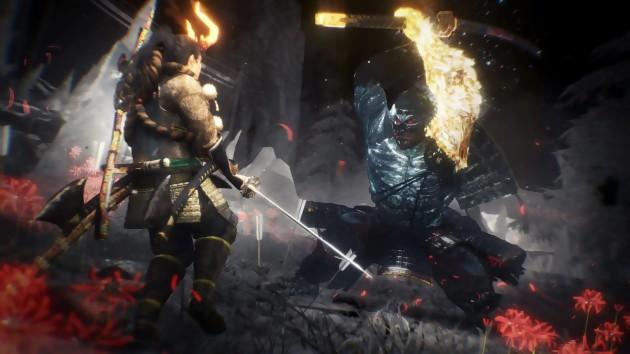 Team Ninja made both sides of our avatar complementary, and it works pretty well. If youkai are comfortable in their dark realm, it is also true for us when we transform. We don't necessarily think about it: in a desperate maneuver, this is how we tore off a good part of Kamaitachi's vital gauge, before finishing him badly. Fighting opponents the old way (only with edged weapons) is perfectly possible, but it's complicating the task for nothing. Anyway, although they will never say it openly, we feel that the developers are pushing us gently to exploit the dark side of our character, even if it means raising the degree of difficulty in certain very specific areas. And don't count on the flaws of Onmyo magic to get you out of it unscathed. No doubt made aware that certain bosses were punching bags with the "Sloth" spell in Nioh, the studio has endeavored to balance the trick even if flaws remain. Like the first episode, Nioh 2 is a love letter to loot: we stack without calculating, until a message warns us that the inventory is full. Since a complete set grants bonuses that are often crucial in times of difficulty, we take the time to scrutinize every corner while looking death straight in the eye. Too bad if you have to use six vials and dig into Amina's gauge to eliminate the golgoth in the corner, the reduction in weight promised by the helmet which is just behind it is worth it; and lightening your stuff means relieving the stamina gauge, and therefore benefiting from one or two more hits that are likely to make a difference. The devil is in the details.
Team Ninja made both sides of our avatar complementary, and it works pretty well. If youkai are comfortable in their dark realm, it is also true for us when we transform. We don't necessarily think about it: in a desperate maneuver, this is how we tore off a good part of Kamaitachi's vital gauge, before finishing him badly. Fighting opponents the old way (only with edged weapons) is perfectly possible, but it's complicating the task for nothing. Anyway, although they will never say it openly, we feel that the developers are pushing us gently to exploit the dark side of our character, even if it means raising the degree of difficulty in certain very specific areas. And don't count on the flaws of Onmyo magic to get you out of it unscathed. No doubt made aware that certain bosses were punching bags with the "Sloth" spell in Nioh, the studio has endeavored to balance the trick even if flaws remain. Like the first episode, Nioh 2 is a love letter to loot: we stack without calculating, until a message warns us that the inventory is full. Since a complete set grants bonuses that are often crucial in times of difficulty, we take the time to scrutinize every corner while looking death straight in the eye. Too bad if you have to use six vials and dig into Amina's gauge to eliminate the golgoth in the corner, the reduction in weight promised by the helmet which is just behind it is worth it; and lightening your stuff means relieving the stamina gauge, and therefore benefiting from one or two more hits that are likely to make a difference. The devil is in the details.
HAVE THE DEMON
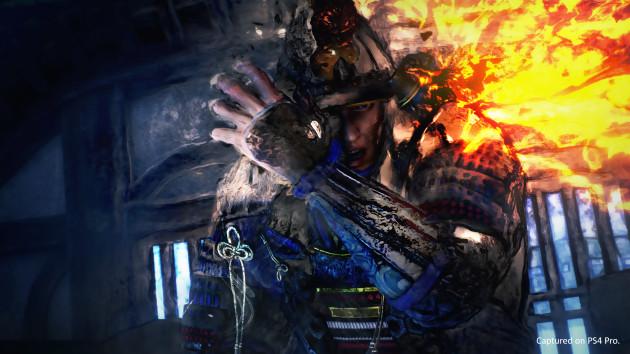 Exactly, on the interface side, not much has been done to improve the already very limited readability of the first opus. Even for insiders, it's not easy to navigate as the menus pile up without the slightest coherence. With such a mess, how do you expect laymen not to be discouraged? Come on, we want to recognize that efforts have been made in terms of skills: instead of the pesky scrolls, we are entitled to a classic tree where the evolution of the character is easier to follow. And although we also appreciate this effect of transparency which prevents being completely cut off from the action which continues (the pause is active), it remains insufficient in terms of ergonomics. Fortunately, these inconveniences do not affect the quality of the level design. We know the song: the possibility of taking different paths to the next shrine, praying not to run into angry Yôkai as the amount of Amrita increases. After getting a taste of Sekiro's verticality, returning to a more horizontal exploration may seem a tad bland. That said, the house has such a mastery of its subject that it is able to make us (without our realizing it) go around an area to arrive at a checkpoint which, in reality, is the same as we left a few minutes ago; except that in the meantime, we've unlocked a shortcut that means you don't have to take the detour a second time, except to grind. In fact, Nioh 2 is above all exotic, one of the advantages offered by chaptering which we are not very fond of to be honest. This was already the case in Nioh, and we naively hoped that the formula would evolve so that we did not have to systematically go through the map between each mission. Shit.
Exactly, on the interface side, not much has been done to improve the already very limited readability of the first opus. Even for insiders, it's not easy to navigate as the menus pile up without the slightest coherence. With such a mess, how do you expect laymen not to be discouraged? Come on, we want to recognize that efforts have been made in terms of skills: instead of the pesky scrolls, we are entitled to a classic tree where the evolution of the character is easier to follow. And although we also appreciate this effect of transparency which prevents being completely cut off from the action which continues (the pause is active), it remains insufficient in terms of ergonomics. Fortunately, these inconveniences do not affect the quality of the level design. We know the song: the possibility of taking different paths to the next shrine, praying not to run into angry Yôkai as the amount of Amrita increases. After getting a taste of Sekiro's verticality, returning to a more horizontal exploration may seem a tad bland. That said, the house has such a mastery of its subject that it is able to make us (without our realizing it) go around an area to arrive at a checkpoint which, in reality, is the same as we left a few minutes ago; except that in the meantime, we've unlocked a shortcut that means you don't have to take the detour a second time, except to grind. In fact, Nioh 2 is above all exotic, one of the advantages offered by chaptering which we are not very fond of to be honest. This was already the case in Nioh, and we naively hoped that the formula would evolve so that we did not have to systematically go through the map between each mission. Shit.
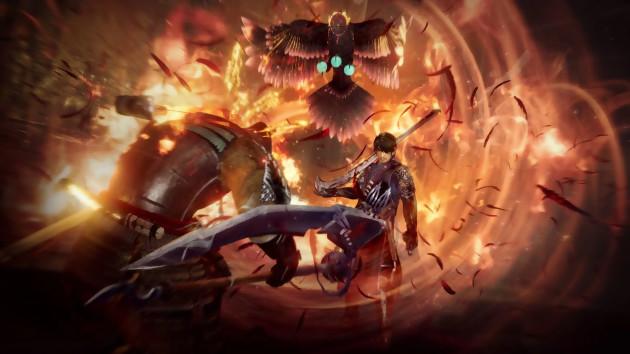 Still, Feudal Japan as Team Ninja conceives of it has a lot going for it in terms of art direction. Knowing nothing about the Sengoku era does not prevent you from appreciating the typical buildings of the time and the ornaments they could contain; and if you are insensitive to the beauty of the temples, perhaps the exteriors will capture your attention, without forgetting the caves and their infernal mazes. In short, Nioh 2 is in line with its predecessor by offering a variety of tones, atmospheres and colors that are quite crazy. In addition, the developers have plunged their hands into Japanese folklore to bring out a bestiary of exhilarating richness, which makes it possible to correct one of the main faults of Nioh. The duplication effect – especially when we decide to stuff ourselves with side quests – is less felt suddenly, and it also has the merit of getting us out of our comfort zone, since attitudes change from one enemy to another. 'other. Just in case, we remember that we have the choice between 4K 30fps, 1080p 60fps, or 4K with a variable framerate. A word, too, on the multi that we could not try at the time of the test, but which should be mentioned briefly. Clearly, the new blue tombs show an ally (embodied by the AI) who will not hesitate to die in battle. Useful against mobs, less against a deter boss from which it will remove an anecdotal portion of life. That's why it's more interesting to solicit two friends with whom we can build a squad of three warriors. It's unclear if the developers took the opportunity to adjust the difficulty level, with many Nioh fans complaining that playing two-up made progress far too easy.
Still, Feudal Japan as Team Ninja conceives of it has a lot going for it in terms of art direction. Knowing nothing about the Sengoku era does not prevent you from appreciating the typical buildings of the time and the ornaments they could contain; and if you are insensitive to the beauty of the temples, perhaps the exteriors will capture your attention, without forgetting the caves and their infernal mazes. In short, Nioh 2 is in line with its predecessor by offering a variety of tones, atmospheres and colors that are quite crazy. In addition, the developers have plunged their hands into Japanese folklore to bring out a bestiary of exhilarating richness, which makes it possible to correct one of the main faults of Nioh. The duplication effect – especially when we decide to stuff ourselves with side quests – is less felt suddenly, and it also has the merit of getting us out of our comfort zone, since attitudes change from one enemy to another. 'other. Just in case, we remember that we have the choice between 4K 30fps, 1080p 60fps, or 4K with a variable framerate. A word, too, on the multi that we could not try at the time of the test, but which should be mentioned briefly. Clearly, the new blue tombs show an ally (embodied by the AI) who will not hesitate to die in battle. Useful against mobs, less against a deter boss from which it will remove an anecdotal portion of life. That's why it's more interesting to solicit two friends with whom we can build a squad of three warriors. It's unclear if the developers took the opportunity to adjust the difficulty level, with many Nioh fans complaining that playing two-up made progress far too easy.


























